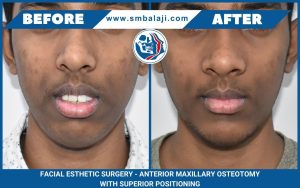Patient develops lower jaw swelling about a year ago
The patient is a 24-year-old male from Hoskote in Karnataka, India. He developed a swelling in the region of the left lower jaw around a year ago. This was especially alarming since he has always had asymmetry of the face with deviation of the mandible to the left side. The swelling was also associated with pain and subsequent tooth mobility in the involved region.
This had been followed by a visit to a local dental clinic where radiographic imaging had been obtained. A provisional diagnosis of odontogenic keratocyst had been made by the specialist there. It was explained to the patient that he needed to undergo left-sided partial mandibulectomy to resect the lesion. This would need to be followed by reconstruction of the jaw.
He had subsequently undergone surgery at a nearby city. The lesion had been resected, but unfortunately the condyle had been displaced superiorly into the region of the lateral pterygoid. This had resulted in worsening asymmetry of his face. The patient had become extremely distressed by this turn of events.
His parents had presented to the operating surgeon for a solution to his problem. Realizing the enormity of the condylar surgical correction and reconstruction required by the patient, the patient had been referred to our hospital for treatment.
What is an odontogenic keratocyst and how is it managed?
An odontogenic keratocyst is benign developmental cyst that is locally aggressive. Peak incidence is mostly during the second or third decades of life. At least 50% of odontogenic keratocysts are found in the posterior body and lower ramus of the mandible. Segmental mandibulectomy is performed, but results in gross residual deformities of the face.
Swelling is the most common presenting complaint. They may also be asymptomatic and found incidentally on dental radiographs. Plastic reconstructive surgery is necessary to full rehabilitate the patient. Usage of distraction devices helps restore facial symmetry. Implant treatment enables replacement of lost teeth.
Initial presentation at our hospital for treatment of his odontogenic keratocyst
Dr SM Balaji, jaw reconstruction surgeon, had examined the patient and obtained comprehensive imaging studies including a 3D CT scan. The 3D CT confirmed that the condyle had been superiorly displaced into the region of the lateral pterygoid muscle. He explained to the patient that he needed reconstruction of his resected jaw through bone grafts harvested from the patient.
He further explained that the patient’s idiopathic facial asymmetry could also be corrected through mandibular internal distractor surgery. A detailed explanation of the treatment process was given to the patient. Realizing that corrective jaw surgery would result in complete resolution of his facial asymmetry, the patient happily consented to undergo this surgery.
Successful mandibulectomy and internal distractor placement surgery
Under general anesthesia, the condyle was first brought back into correct anatomical position. This was followed by reconstruction of the resected mandible using the bone grafts. The bone grafts were fixed in position using titanium screws.
He also underwent placement of a left mandibular ramus distractor. A latency period of one week was allowed following placement of distractor. The distractor was subsequently activated by 1 mm each day for 18 days. This achieved an increase of 18 mm of mandibular distraction on the left side.
The time frame was explained to the family before surgery. It was explained that six months would be required for full consolidation of the new bone. He was instructed to return in six months. Distractor device would be removed and implants would be placed at that point. The patient expressed understanding of the instructions.
Patient returns for distractor removal surgery and dental implant surgery
A 3D CT scan was obtained at the site of distraction to check for bone consolidation. There was also good consolidation of the bone grafts at the site of the jaw reconstruction surgery. This was explained to the patient and he was scheduled for distractor removal and implant placement.
Removal of mandibular distractor and placement of dental implants
Under general anesthesia, an incision was placed in the left posterior region at the region of the distractor. A flap was then raised followed by removal of the left mandibular ramus distractor. Nobel Biocare dental implants were then placed in relation to the left mandibular second premolar and second molar. Hemostasis was achieved and wound closure was done using resorbable sutures.
Successful outcome of surgery with complete patient satisfaction
Complete symmetry of the patient’s face had been established through the distraction. The patient was extremely happy that he now had good facial harmony. He expressed how this would result in greatly increased social acceptance amongst peers. It was explained to him that he needed to return in three to four months for placement of ceramic crowns on the dental implants.
The patient expressed complete understanding of the instructions and expressed his happiness before discharge from the hospital.





